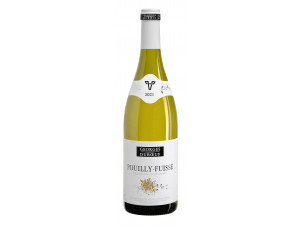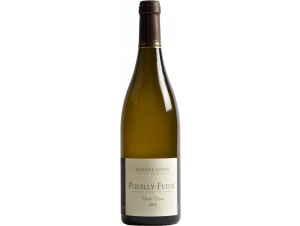You have no items in your shopping cart.
Wine Pouilly-Fuissé
-
Top Selling
-
Top Selling
-
Top Selling
- -10%
- -10%
- -10%
- -10%
- -10%
- -17%
- -15%
- -10%
- -11%
The history of Pouilly-Fuissé goes back to the Middle Ages
The wine history of Pouilly Fuissé really begins in the Middle Ages and those in particular through the wine trade that transited on the Saône. The Abbey of Cluny, owner of plots of land, greatly favoured the wine development of the region. The vineyard is until the eighteenth century mostly planted in Gamay. The nineteenth century, is a period of transition for viticulture, accelerated by the phylloxera crisis. The Chardonnay replaces the Gamay, to become the sole grape variety of the AOC.
In 1922, the court of Mâcon rules on the limits of the geographical area of the vineyard to put an end to the fraudulent use of the name of the appellation and to protect the singular and remarkable character of these crus. In 1929, the 4 mayors mobilised to protect the AOC and created the Union des Producteurs de Pouilly Fuissé. This commitment led to the recognition of the AOC Pouilly Fuissé, by the INAO, in 1936. In 1995, the Hospices de Beaune will be awarded 4 ha of vineyards of the appellation. Pouilly Fuissé is the only AOC outside the Côte d'Or to be represented there.
The terroir of Pouilly-Fuissé is composed of limestone and granite
The AOC Pouilly Fuissé, extends over 4 communes which are Vergisson, Solutré-Pouilly, Fuissé and Chaintré (From North to South of the appellation). The surface area of the production zone of 760 ha shows a great geological diversity.
At the foot of the Vergisson rock we find the second geological family with chalk-rich soils which will confer elegance and minerality to the wines from these terroirs. These limestone-rich soils will be present right up to the foot of the Roche de Solutré. To the east of the Roche de Solutré and those up to the village, the vineyard is established on limestone soils but exposed to the east, the wines obtained are more aromatic.
In the commune of Fuissé, there are chalky soils and subsoils and granitic soils. The limestone soils are present on the Beauregard plateau and on part of the village of Fuissé. In the second case, the vineyard is located in an amphitheatre around the village with an eastern exposure. While the first terroir, gives complex wines suitable for a very long ageing, the second terroir gives a rich solar wine. The granitic soils are located to the east of the village. They will give supple wines, easy to drink in their youth.
Finally, in the South of the AOC, in the commune of Chaintré, the vineyard is located on a hillside, facing East, opposite the Saône. The soils are clay-limestone, deeper on the plain. The wines obtained are mineral, fresh and fruity.
The climate is oceanic with southern influences that moderate temperatures and rainfall. The vineyard is also protected from heavy rainfall by the Charolais relief located to the west.
What are the main characteristics of a Pouilly-Fuissé?
The diversity of soils in the AOC gives the wines a beautiful diversity where each soil accentuates a typicity. The white wines of Pouilly Fuissé are made from Chardonnay.
The robe is golden with more or less sustained nuances. The nose develops a beautiful aromatic palette. We thus find notes of dried fruit (almonds and hazelnuts), citrus, white flowers (lime and acacia) but also more mineral notes of flint. There are also brioche notes characteristic of Chardonnay.
The palate has a nice structure, rich more or less opulent and complex depending on the soil of origin.
Pouilly-Fuissé goes well with a multitude of dishes
The white wines of Pouilly Fuissé are best enjoyed with shellfish such as prawns, lobster or lobster. It can also be enjoyed with semi-cooked foie gras. White meats (veal and poultry) and goat's cheese are classic but always successful matches. For lovers of exotic dishes, Pouilly Fuissé wines can be paired with couscous, fish tajine, sweet and sour shrimp and sushi.
What are the fine vintages of Pouilly-Fuissé?
Pouilly Fuissé has very good aromatic qualities in the following vintages: 1928, 1929, 1937, 1945, 1947, 1949, 1950, 1953, 1959, 1961, 1962, 1966, 1969, 1971, 1978 and 1996. Closer to home we note 2005, 2010 and 2014.
The must-have domains of Pouilly-Fuissé
The Domaine Barraud
Domaine Barraud is located in Vergisson, between the rocks of Solutré and Vergisson. It was taken over by Julien Barraud in 2006, and continues the traditions and respect for the environment established by his father. They vinify 3 AOC: Mâcon village, Pouilly Fuissé and Saint Véran.The J.A.Ferret estate
The J.A.Ferret estate is located in Fuissé, its reputation has been acquired thanks to the understanding of the terroirs and a parcel-based vinification applied by Audrey Braccini, director and oenologist of the estate. Audrey Braccini's goal is to take the domain to biodynamic farming. Acquired in 2008, by the Kopf family (owners of Jadot), the estate has kept its identity.Blagny
Burgundy Rosé
Burgundy-Chitry
Burgundy-Côte-Chalonnaise
Burgundy-Côte-Saint-Jacques
Burgundy-Côtes-d'Auxerre Rosé
Burgundy-Côtes-du-Couchois
Burgundy-Épineuil
Burgundy-Grand-Ordinaire
Burgundy-Hautes-Côtes-de-Beaune
Burgundy-Hautes-Côtes-de-Nuits
Burgundy-Vézelay
Crème de fruits
Criots-Bâtard-Montrachet
La Tache
Liqueur
Mâcon Supérieur
Mâcon-Chaintré
Mâcon-Chardonnay
Mâcon-Solutré A.O.C.
Mâcon-Vergisson
Mazoyères-Chambertin
Pouilly-Loché
Vin de Pays de Sainte-Marie-la-Blanche





























 TWIL - Achat de Vin
TWIL - Achat de Vin


